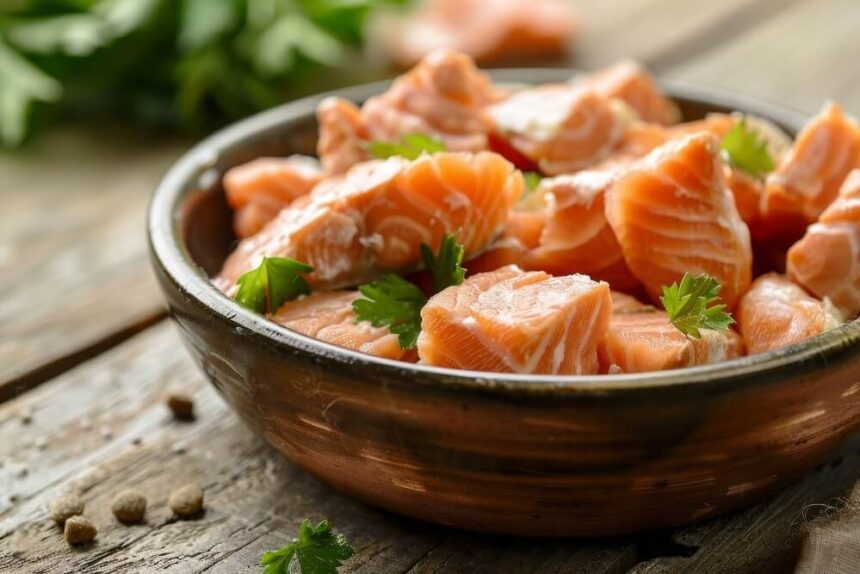Ever thought about what goes into those little tins of cat food? Maybe it’s time to ditch the store-bought stuff and try something fresher for your furry friend. Today, we’re diving into a Homemade Salmon Cat Food Recipe that’s not only super healthy but also a big hit with cats. Trust me, your feline buddy will thank you with extra purrs and cuddles.
Why Your Cat Needs Salmon
Cats are natural carnivores, which means they thrive on protein. Salmon is packed with high-quality protein and essential amino acids that help with muscle development. But that’s not all! Salmon is also rich in omega-3 fatty acids, which are fantastic for your cat’s skin and coat. Ever noticed how your cat’s fur gets shinier after a fishy treat? That’s omega-3s doing their magic.
Plus, salmon is loaded with vitamins like B12 and D, along with minerals such as selenium and niacin. These nutrients play a huge role in boosting your cat’s immune system, keeping them healthy and playful.
Why Make Homemade Cat Food?
Let’s face it. Commercial cat food can be a mystery. Long lists of ingredients that are hard to pronounce and preservatives that aren’t great for anyone. Making homemade cat food gives you control over what your cat eats. You get to choose fresh, high-quality ingredients, ensuring there are no nasty chemicals or fillers.
Homemade cat food can also save you money in the long run. It’s easy on the wallet and takes just a little time to prepare. And the best part? Seeing your cat’s excited reaction to a homemade meal. Priceless!
Getting Started with Homemade Salmon Cat Food Recipe
Ready to cook? Great! Let’s break it down into simple steps.
Recipe Details
- Time: 30 minutes
- Yield: 6 servings
What You’ll Need
- Non-stick skillet
- Mixing bowls
- Measuring cups and spoons
- Knife and cutting board
- Steamer or pot for vegetables
- Fork or potato masher
- Airtight container for storage
Ingredients
- 1 pound fresh salmon (boneless and skinless)
- 1/2 cup carrots, finely chopped
- 1/2 cup peas, steamed and mashed
- 1/2 cup cooked rice, cooled
- 1 large egg, hard-boiled and chopped
- 1 tablespoon olive oil
- Cat-safe vitamins and minerals (as recommended by your vet)
Step-by-Step Instructions
Prep the Ingredients
Start by rinsing the salmon under cold water and pat it dry. Finely chop the carrots and steam them until they’re nice and tender. Do the same with the peas, then mash them up. Cook the rice according to package instructions and let it cool. Hard boil the egg, peel it, and chop it into small pieces.
Cook the Salmon
Heat up a non-stick skillet with the olive oil over medium heat. Add the salmon and cook for about 4-5 minutes on each side, or until it flakes easily with a fork. Let the salmon cool slightly before handling it.
Mix It All Up
In a large mixing bowl, combine the cooked salmon, chopped carrots, mashed peas, cooled rice, and chopped egg. Mix thoroughly to ensure all the ingredients are evenly distributed.
Add the Good Stuff
This is where the magic happens. Add the recommended vitamins and minerals to the mixture. Mix well to ensure the supplements are spread throughout the food.
Serve and Store
Serve the salmon cat food at room temperature. Start with small portions to see how your cat likes it. Store any leftovers in an airtight container in the fridge for up to three days. For longer storage, freeze portions for up to three months.
Nutritious Breakdown
Wondering what’s in each serving? Here’s the lowdown:
- Calories: 120
- Protein: 15g
- Fat: 6g
- Carbs: 4g
- Fiber: 1g
- Vitamins and Minerals: As per the supplements added
Serving Suggestions
I recommend serving this meal fresh and at room temperature. Mix it with a bit of warm water to enhance the aroma, making it more appealing to your cat. Always keep an eye on your cat while they’re eating to ensure they enjoy the meal and don’t have any adverse reactions.
Tips and Tricks for the Best Homemade Salmon Cat Food Recipe
- Introduce Slowly: If your cat is new to homemade food, transition gradually from their current food to avoid digestive issues.
- Switch Up Veggies: Feel free to substitute the carrots and peas with other cat-safe vegetables like spinach or zucchini.
- Fresh Ingredients Are Key: Always use fresh, high-quality ingredients to ensure your cat gets the best nutrition.
- Vet Approval: Before making significant changes to your cat’s diet, always consult your vet to ensure it meets their nutritional needs.
Health Benefits of Homemade Salmon Cat Food
There are so many reasons to love this recipe beyond just its taste:
- High Protein: Essential for muscle development and overall health.
- Omega-3 Fatty Acids: Promotes healthy skin and a shiny coat.
- Vitamins and Minerals: Ensures a balanced diet with all necessary nutrients.
- Digestive Health: Fiber from the veggies aids in digestion.
How Much to Feed Your Cat
So, how much of this homemade goodness should your cat be eating? Start by checking the guidelines on your cat food package, as these are usually based on weight. For an average adult cat, about 1/4 to 1/3 cup of this homemade food per meal is a good start.
Remember, adult cats generally need around 24 to 35 calories per pound of body weight per day. This can vary depending on your cat’s age, activity level, and overall health. If your cat seems hungry or is gaining weight, adjust the portion size accordingly. Always discuss your cat’s diet with your vet to get personalized advice.
Is Salmon the Right Protein for Cats?
Absolutely! Salmon is a fantastic protein source for cats. It’s rich in essential amino acids, which are crucial for muscle maintenance and overall health. The omega-3 fatty acids in salmon also help improve your cat’s skin and coat health. Plus, many cats love the taste of salmon, making it a great ingredient for meals.
How Much Salmon Can a Cat Eat?
If you’re giving salmon as a treat, it shouldn’t exceed 10% of your cat’s daily caloric intake. Most cats can safely enjoy a few small pieces of salmon, equivalent to about a tablespoon or two. If you’re incorporating salmon into your cat’s regular diet, follow the feeding guidelines on the package to ensure a balanced diet.
Wrapping It Up
Making homemade cat food can be a rewarding way to ensure your feline friend gets high-quality, nutritious meals. This Homemade Salmon Cat Food Recipe is simple to prepare and packed with essential nutrients to keep your cat healthy and happy.
Remember to always consult your vet and monitor your cat’s health regularly. With this recipe, you’re not just feeding your cat; you’re giving them the best care possible. Enjoy the joy of cooking for your pet and the satisfaction of knowing exactly what goes into their food. Happy cooking!



